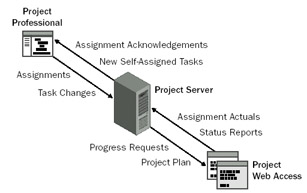Understanding Project Workgroup Collaboration
Communication is a critical component of effective project management. There's no question that establishing an effective two-way information flow prevents a host of problems.
Project Server and Project Web Access provide a highly efficient process for exchanging project information with team members . As the project manager working in Project Professional and Project Web Access, you can transmit project information through Project Server to do the following:
-
Submit assignments and task changes to assigned resources.
-
Request assignment actuals from assigned resources.
-
Request, receive, and compile narrative status reports .
-
Incorporate actuals submitted by assigned resources directly into the project plan.
-
Publish the full project plan for review by team members and other stakeholders.
Note In Project 2002, you could implement workgroup collaboration using either Project Standard or Project Professional. In Project 2003, you must use Project Professional.
Cross-References For details about workgroup collaboration information for the project manager, see Chapter 22.
With Project Web Access, team members can see all the relevant project information for their assignments. The Web site that is their Project Web Access page (see Figure 20-2) has an easy-to-navigate layout that simplifies information flow.

Figure 20-2: Team members use the Project Web Access Timesheet to manage their assignments.
Using Project Web Access, team members can do the following:
-
Accept (or reject) task assignments.
-
Create and self-assign new tasks for addition to the project plan.
-
Add comments to assignments that become part of the project task record.
-
Update task information for incorporation in the project plan.
-
Enter daily or weekly actuals, specify percent complete, or indicate the amount of completed and remaining work to report progress on assignments and submit them to the project manager for incorporation into the project plan.
-
Review assignments in different views, with applied filters, groups, and sorting.
-
Review the entire project plan to see the context of individual assignments.
Information updated or changed by team members is stored initially in the Project Server database. As project manager, you can accept or reject changes. If you accept an update, you can incorporate it immediately into your project plan. The Project Server database is then updated to show that the change has been accepted, and team members who review the project plan through Project Web Access can see the updates (see Figure 20-3).

Figure 20-3: The project manager and team members exchange information via Project Server.
In the Project Web Access intranet site, team members can see different views of project data, review assignments, enter time reports, update tasks, view summary project plans, send information to the project manager, and more. Each Project Web Access user can individually customize his own view to enhance individual efficiencies.
| Cross-References | For details about workgroup collaboration information for the team member, see Chapter 23. |
Project Web Access is not just for team members, though. Any stakeholders ”including functional managers, customers, human resources representatives, and finance managers ”can be set up with a user name and a personalized set of permissions to access their view of Project Server through Project Web Access.
If your organization also uses Windows SharePoint Services, additional functions can be integrated into the Project Web Access experience:
Document check-in and checkout. You can include project- related documents with the project, and even associate them with individual tasks or phases. You can implement version control through document check-in and checkout processes.
Issues tracking . You can record issues associated with a task or phase. You can then track the issues, assign responsibility, and close them when they're resolved. The issue becomes a part of the task history.
Risk management. You can record potential risks associated with a task or phase, along with mitigation plans should the risk become a reality. You can assign responsibility and track the risk and then close the risk record when appropriate. The risk information becomes a part of the task history, which can be especially helpful when planning another similar project.
| Note | The implementation of Windows SharePoint Services requires that Project Server run in enterprise mode and use Windows authentication. |
EAN: 2147483647
Pages: 268